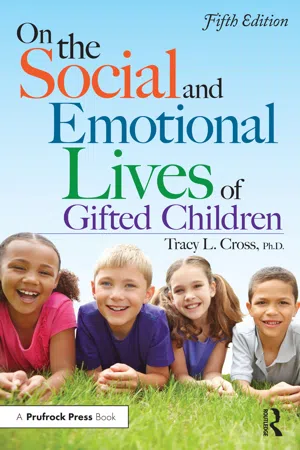
- 378 pages
- English
- ePUB (mobile friendly)
- Available on iOS & Android
On the Social and Emotional Lives of Gifted Children
About This Book
Raising happy, successful children is a goal of every parent of gifted children. In On the Social and Emotional Lives of Gifted Children, the nation's leading authority on the psychology of gifted children offers advice and encouragement for both parents and teachers. In a thoughtful, conversational style, the author offers an in-depth look at the complex social and emotional issues faced by gifted children. This revised and updated fifth edition of the popular text contains more than 12 new chapters. On the Social and Emotional Lives of Gifted Children tackles important and timely issues dealing with the social and emotional needs of today's gifted children, including who gifted children are and what giftedness means; how parents, teachers, and counselors can guide gifted children; the issues facing gifted students in the 21st century, such as technology and terrorism; and how the education of gifted children can adapt for the future. This concise, sensitive look at gifted children and their social and emotional world offers unique insights for both teachers and parents who support these special children.
Frequently asked questions
Information
SECTION III
Gifted Children Today
CHAPTER 23
Gifted Students’ Social and Emotional Development in the 21st Century23
- Generational influences on psychosocial development
- To know something, one must experience it (idea from Rollo May)
- Global economy’s influence on psychosocial development
- ✧ textbooks and worksheets to computers,
- ✧ teacher-directed to students-as-teachers, and
- ✧ classroom lectures to students becoming responsible for the construction of their own learning through processes of inquiry.
- ✧ slow and sometimes unattainable to immediate and overwhelming,
- ✧ being out in the world collecting information to collecting information from home, and
- ✧ collecting information manually to relying on computers.
- Provide two further examples of how gifted children’s experiences today differ from those of previous generations.
- What strategies (as mentioned in previous chapters) do you think would be most effective in dealing with generational or global influences on gifted individuals’ psychological development?
CHAPTER 24
Technology and the Unseen World of Gifted Students24
- Gifted students’ experiences with computer-based communications technologies fall into four categories: freedom of expression, control, power, and feeling connected
- Erikson’s theory of psychosocial development
- The positive influences of technology on Eriksonian crises
Table of contents
- Cover
- Half Title
- Title Page
- Copyright Page
- Table of Contents
- Foreword
- Preface
- Introduction A Continuum of Psychological Services: Setting the Stage for the Chapters
- Section I About Gifted Children: Who They Are and Why
- Section II Guiding Gifted Children
- Section III Gifted Children Today
- Section IV Suicidal Behavior and Gifted Students
- Section V Where We Have Been and Where We Are Going
- References
- Resources
- About the Author